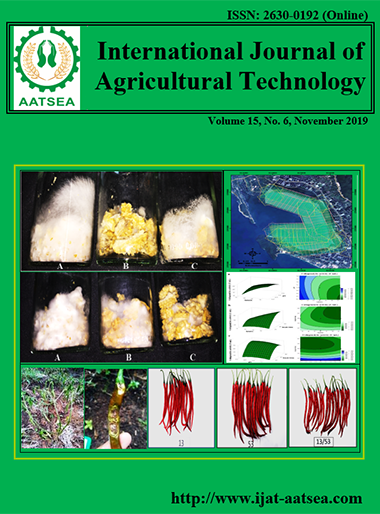Weed inhibition and sorghum yield as affected by organic mulch in tropical coastal environment
Main Article Content
Abstract
Weed control is a common practice in sorghum (Sorghum bicolor, L.) cultivation to prevent yield loss. The results showed that the most weed inhibition was observed in the treatment of rice straw mulch for 5 weeks after planting date (WAP) and at harvesting with a dry biomass weight of 13.49 g and 9.61 g, respectively. Nonetheless, the organic mulch had no prominent effect on sorghum yield. Keller variety had the highest biomass, but the yield was lower than the other two varieties. The result indicated that Keller variety was more suitable for animal feed, while Samurai and Super-2 varieties were prospective for human consumption. In addition, all tested sorghum varieties are potentially cultivated in the tropical coastal environment
Article Details

This work is licensed under a Creative Commons Attribution-NonCommercial-NoDerivatives 4.0 International License.
References
Adinurani, P. G., Rahayu, S., Sulistiyo B. L., Nindita, A. and Soni, P. (2018). Biomass and sugar content of some varieties of sorghum (Sorghum Bicolor L. Moench) on dry land forest as feedstock bioethanol. MATEC Web of Conferences, 164:01035.
Alhajturki, D., Aljamali, M., Kanbar, A. and Azmah, F. (2012). Potential of some sweet sorghum (Sorghum bicolor L.) genotypes under two water regimes for sugar and bio-ethanol production. Sugar Tech 14:376–382. doi: 10.1007/s12355-012-0181-x.
Ekefre, D. E., Mahapatra, A. K., Latimore Jr., M., Bellmer, D. D. and Jena, U. (2017). Evaluation of three cultivars of sweet sorghum as feedstocks for ethanol production in the Southeast United States. Heliyon 3: e00490. doi: 10.1016/j.heliyon.2017.e00490.
Fromme, D. D., Dotray, P. A., Grichar, W. J. and Fernandez, C. J. (2012). Weed Control and grain sorghum (Sorghum bicolor) tolerance to pyrasulfotole plus bromoxynil. International Journal of Agronomy, 2012:1-10. doi: 10.1155/2012/951454.
Goitom, T. (2017). Effect of organic mulches and land preparation methods on soil moisture and sesame productivity. African Journal of Agricultural Research, 12:2836-2843. doi: 10.5897/AJAR2017.12478.
Jodaugienė, D., Pupalienė, R., Urbonienė, M., Pranckietis, V. and Pranckietienė, I. (2006). The impact of different types of organic mulches on weed emergence. Agronomy Research, 4:197-201.
Mahmood, A., Ihsan, M. Z., Khaliq, A., Hussain, S. and Cheema, Z. A. (2016). Crop residues mulch as organic weed management strategy in maize: general. Clean Soil Air Water, 44:317-324. doi: 10.1002/clen.201500155.
Paterson, A. H., Bowers, J. E., Bruggmann, R., Dubchak, I. and Grimwood, J. (2009). The sorghum bicolor genome and the diversification of grasses. Nature, 457:551-556. doi: 10.1038/nature07723.
Prażak, R. (2016). Prospects for sorghum cultivation in Poland. Acta Agrobotanica, 69: DOI: https://doi.org/10.5586/aa.1661.
Saberi, A. R. and S. H. Aisyah. (2013). Growth analysis of forage sorghum (Sorghum bicolor L.) varieties under varying salinity and irigarion frequency. International Journal of Biotechnology, 2:130-140.
Setyowati, N., Nurjanah, U. Muktamar, Z., Sudjatmiko, S. and Chozin, M. (2017). Weed seed inhibition under solarization treatment with different mulch color in tropical highland organic farming system. International Journal on Advanced Science, Engineering and Information Technology, 7:1895-1899.
Simarmata, M., Barchia, M. F. and Simatupang, S. N. (2017). Prospect for growing sorghum (Sorghum bicolor L. Moench) at marginal dry land in coastal area retrieved with organic soil amendments. Asian Journal of Crop Science, 9:118-124. doi: 10.3923/ajcs.2017.118.124.
Sutrisna, N., Sunandar, N. and Zubair, A. (2013). Adaptation test of some varieties of sorghum (Sorghum bicolor L.) on dry land in Ciamis, West Java. J. Soil Sub-optimal, 2:137-147.
Teame, G., Tsegay, A. and Abrha, B. (2017). Effect of organic mulching on soil moisture, yield, and yield contributing components of sesame (Sesamum indicum L.). International Journal of Agronomy, 2017:1-6. doi: 10.1155/2017/4767509.
Upadhyaya, M. K. and Blackshaw, R. E. editors. (2007). Non-chemical weed management: principles, concepts and technology. CABI, Wallingford, UK; Cambridge, MA.
Webber III, C.L., J. W. and L. P. (2012). Organic weed control. In: Alvarez-Fernandez, R., editor, Herbicides - Environmental Impact Studies and Management Approaches. InTech.
Zimdahl, R. L. (2007). Fundamentals of weed science. 3rd ed. Elsevier/Academic Press, Amsterdam; Boston.


